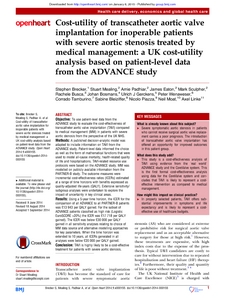Brecker, S;
Mealing, S;
Padhiar, A;
Eaton, J;
Sculpher, M;
Busca, R;
Bosmans, J;
Gerckens, UJ;
Wenaweser, P;
Tamburino, C;
et al.
Brecker, S; Mealing, S; Padhiar, A; Eaton, J; Sculpher, M; Busca, R; Bosmans, J; Gerckens, UJ; Wenaweser, P; Tamburino, C; Bleiziffer, S; Piazza, N; Moat, N; Linke, A
(2014)
Cost-utility of transcatheter aortic valve implantation for inoperable patients with severe aortic stenosis treated by medical management: a UK cost-utility analysis based on patient-level data from the ADVANCE study.
Open Heart, 1 (1).
ISSN 2053-3624
https://doi.org/10.1136/openhrt-2014-000155
SGUL Authors: Brecker, Stephen
![[img]](https://openaccess.sgul.ac.uk/107275/1.hassmallThumbnailVersion/Cost_utility_transcatheter_aortic_valve_implantation.pdf)  Preview |
|
["document_typename_application/pdf; charset=binary" not defined]
Published Version
Download (2MB)
| Preview
|
Abstract
OBJECTIVE: To use patient-level data from the ADVANCE study to evaluate the cost-effectiveness of transcatheter aortic valve implantation (TAVI) compared to medical management (MM) in patients with severe aortic stenosis from the perspective of the UK NHS.
METHODS: A published decision-analytic model was adapted to include information on TAVI from the ADVANCE study. Patient-level data informed the choice as well as the form of mathematical functions that were used to model all-cause mortality, health-related quality of life and hospitalisations. TAVI-related resource use protocols were based on the ADVANCE study. MM was modelled on publicly available information from the PARTNER-B study. The outcome measures were incremental cost-effectiveness ratios (ICERs) estimated at a range of time horizons with benefits expressed as quality-adjusted life-years (QALY). Extensive sensitivity/subgroup analyses were undertaken to explore the impact of uncertainty in key clinical areas.
RESULTS: Using a 5-year time horizon, the ICER for the comparison of all ADVANCE to all PARTNER-B patients was £13 943 per QALY gained. For the subset of ADVANCE patients classified as high risk (Logistic EuroSCORE >20%) the ICER was £17 718 per QALY gained). The ICER was below £30 000 per QALY gained in all sensitivity analyses relating to choice of MM data source and alternative modelling approaches for key parameters. When the time horizon was extended to 10 years, all ICERs generated in all analyses were below £20 000 per QALY gained.
CONCLUSION: TAVI is highly likely to be a cost-effective treatment for patients with severe aortic stenosis.
| Item Type: |
Article
|
| Additional Information: |
This is an Open Access article distributed in accordance with the Creative Commons Attribution Non Commercial (CC BY-NC 4.0) license, which permits others to distribute, remix, adapt, build upon this work non-commercially, and license their derivative works on different terms, provided the original work is properly cited and the use is non-commercial. See: http://creativecommons.org/licenses/by-nc/4.0/ |
| Journal or Publication Title: |
Open Heart |
| Article Number: |
e000155 |
| ISSN: |
2053-3624 |
| Language: |
eng |
| PubMed ID: |
25349700 |
| Dates: |
| Date |
Event |
| 2014-10-23 |
Published |
|
 |
Go to PubMed abstract |
| URI: |
https://openaccess.sgul.ac.uk/id/eprint/107275 |
| Publisher's version: |
https://doi.org/10.1136/openhrt-2014-000155 |
Statistics
Item downloaded times since 10 Feb 2015.
Actions (login required)
 |
Edit Item |



